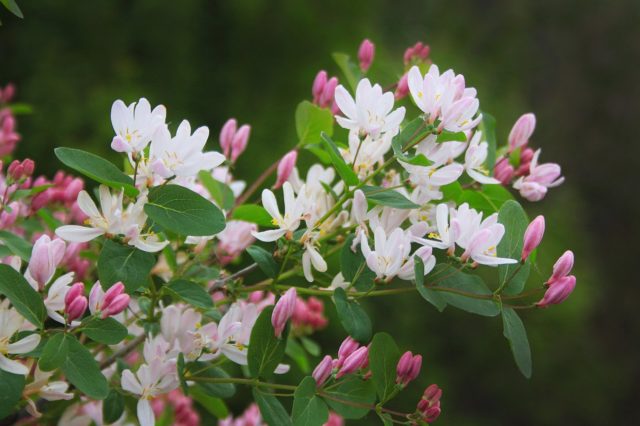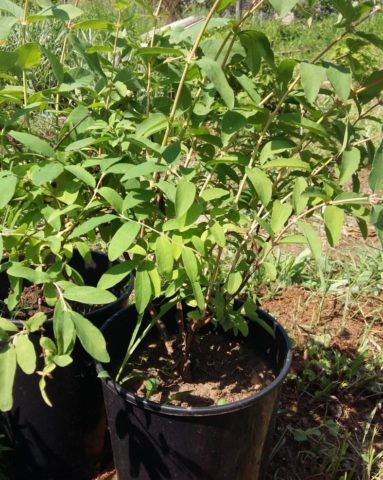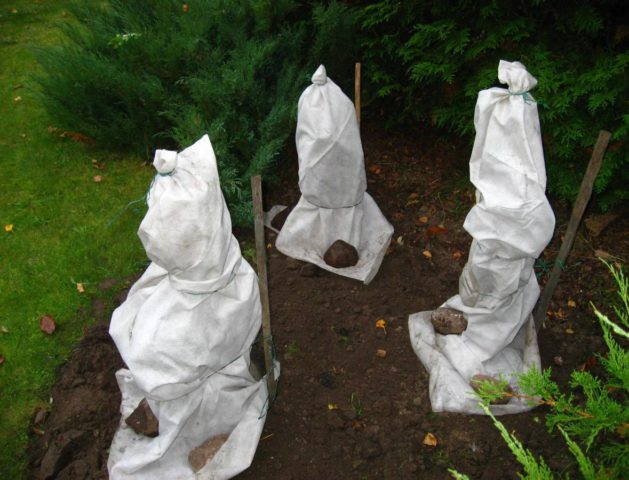Content
At the end of the 80s, an edible variety of the Chosen culture was created on the basis of wild varieties of Kamchatka honeysuckle at the Pavlovsk experimental station of the VIR settlement. After variety testing in 2001, it was entered in the State Register. Description of the honeysuckle variety Chosen One says that the plant is suitable for cultivation in all regions of Russia. With proper agricultural technology, the crop gives a good harvest of large berries with high nutritional value.
Description of honeysuckle Chosen
Honeysuckle is characterized by early fruiting. The flowering and ripening of the berries takes place in the spring, the standard varieties give a harvest in May. Honeysuckle Chosen One is distinguished by late fruiting. Late flowering makes it possible to grow crops in the Leningrad, Moscow region, in the southern regions, but the most comfortable zone for it is Siberia and the Urals.
The Chosen One blooms in late May or mid-June (depending on growing conditions), fruits from August to September. Flowering is not threatened by recurrent frosts, therefore, the shrub yield is good (more than 3 kg). The Chosen variety is classified as early ripening, the first crop is harvested from a four-year-old plant.
Characteristics of edible honeysuckle Chosen:
- The culture grows in the form of a low loose shrub, the maximum height is 1.2 m.
- Stems are upright, with drooping tops, forming a sprawling, non-thickened crown.
- At the first stages of development, the Chosen One gives a slight increase, the growing season of a young plant is aimed at building up the root system. At the 3rd year of growth, honeysuckle begins to intensively form the aboveground part; during the season, shoot formation can reach 50 pieces.
- Young shoots are distinguished by a smooth green bark with a slight brown tint. Perennial branches have a rough surface of dark gray color, on which areas of exfoliating bark are visible.
- Stems are densely leafy, lanceolate leaf plates, with sharp tops, oblong, bright green. The chosen one is a deciduous plant, by autumn the color of the crown becomes brown-green. Leaves with large stipules, smooth edges, with light edging.
- The flowers of the Chosen One are pink, with long petals, arranged in pairs (less often singly), in the leaf axils of last year's shoots. On old branches, flowering is rare or not at all.
- The berries of this variety are large: weight - 1.2 g, length - 2 cm. The peel is thin, dense, smooth, dark blue with a silvery bloom. The surface is slightly bumpy.
Berries of the Chosen variety are oval, with a sharp top
- The pulp is beige, juicy, the taste of honeysuckle is balanced, bitterness is present only with improper agricultural technology. The chosen one, according to the tasting assessment, scored 4.9 points out of 5, the variety is referred to as dessert.
- The berries of the Chosen One hold firmly on the stalk, the separation is dry, they do not crumble from the bush. Stored for a long time, transportable.
Honeysuckle Chosen one inherited high frost resistance from a wild-growing culture, calmly tolerates a drop in temperature to -35 0C. The culture is not afraid of spring frosts. The plant has strong immunity. Pests and diseases are rarely affected. This usually happens if the honeysuckle is growing in the wrong place.
The chosen one retains decorativeness until the onset of winter, so honeysuckle is often used in gardening and landscape design to create certain compositions.

Abundant flowering, the main place of budding is at the tops of last year's shoots
Planting and caring for honeysuckle Chosen
Each plant has specific biological needs. Honeysuckle Chosen One is undemanding to growing conditions, but following the recommendations for its cultivation will help to get a good harvest.
Landing dates
The biological cycle of honeysuckle slows down after harvest, so it is better to plant the Chosen variety on the site in autumn. There are no definite terms, it all depends on the climatic features of the region.
It will take at least 30-45 days for the rooting of young honeysuckle, only then will it calmly endure low temperatures. For temperate climates, the recommended planting time is early September. In the south, the Chosen One can be planted in the spring before flowering or in the fall (around October).
Selection and preparation of the landing site
The key to a full-fledged vegetation and good fruiting will be a place correctly allocated for honeysuckle. The culture is native to northern latitudes, so in hot climates in direct sunlight, honeysuckle berries are baked and the stems dry. A site for planting the Chosen variety is better to pick up with partial shade or temporary shading.
Under the crown of large-sized trees (with a shortage of ultraviolet radiation), the photosynthesis of honeysuckle drops significantly, the shrub grows slowly, the stems are stretched, the flowering weakens, the fruits become small, sour, and bitterness appears. Also not suitable for cultivating Chosen one north side behind the wall of the building. Honeysuckle does not tolerate gusts of cold wind, so the plant must be protected from drafts.
The soil is chosen with a neutral or slightly acidic reaction, the alkaline environment inhibits the growing season. The soil must be adjusted to neutral. The Chosen One will not grow on sandy soil or heavy clay; loamy fertile soils with good aeration and drainage are suitable for her.
Honeysuckle Chosen is characterized by moderate drought resistance. When the root ball dries up, it can die, a lack of moisture poses a particular threat to a young plant. Waterlogged soil is also detrimental to the seedling. A wetland or area with closely spaced groundwater often causes fungal infections and root rot.
After choosing a place, the earth is dug up, weeds are removed along with the root. If it is necessary to adjust the composition of the soil, activities are carried out in advance, 2 months before planting. If the soil meets the requirements of honeysuckle, the site can be prepared immediately before planting.
Landing rules
It is better to purchase a seedling in a nursery; for breeding, preference is given to a two-year-old material. During this time, the honeysuckle will form a sufficient root system and at least 4 shoots. A seedling with an open root is placed in a manganese solution for disinfection, then in "Kornevin" to stimulate growth. The closed root does not require such activities.

After removing the protective material, the honeysuckle is transplanted into the ground together with an earthen lump
Digging a hole. It should be about 10 cm wider than the root volume. The hole depth is approximately 40-50 cm. A nutrient substrate is prepared from compost, peat and soil, if the soil is heavy, sand is added. Drainage is placed at the bottom of the recess, and half of the mixture is poured.
Landing Algorithm:
- Honeysuckle is placed in the center of the pit.
- Sprinkle the roots with a substrate, compact.
- The remaining mixture is added; voids near the root system must not be allowed.
- The earth is tamped with hands.
- Water abundantly.
To preserve moisture, the seedling is mulched and the shoots are cut by 1/3. If several honeysuckle bushes are planted, be sure to keep 1.5 m between them.
Watering and feeding
The first 2 years of growth do not feed honeysuckle. The main fertilization event begins from the time of budding, in the spring the Chosen One is fed with urea and organic means. In the fall, for the establishment of vegetative buds, fertilize with a complex mineral agent and compost. For honeysuckle, slightly acidic soils are desirable, therefore organic feeding is recommended.
In subsequent seasons, the irrigation regime is oriented towards precipitation. Do not allow the soil to dry out and waterlogging.
Pruning Honeysuckle Chosen
The main number of buds is formed on annual shoots, there are flowers on biennial ones, but much less, therefore, older branches are left only as skeletal ones. For a strong bush, a base of 5-7 branches is enough. Pruning is carried out depending on the growing season:
- First pruning immediately after planting.
- For the next 3 years, honeysuckle will grow a root, so the tops of all stems are cut off, this is necessary to stimulate shoot formation.
- In the fourth year, the formation of the bush is necessary. It is carried out after picking berries. Leave the central strong branches as skeletal ones, remove weak shoots, thin out the center of the bush.
- In subsequent years, honeysuckle is sanitized.
Wintering
For adult honeysuckle, Chosen One, a crown shelter for the winter is not required. In warm climates, after pruning, the shrub hibernates without additional measures, the plant is watered abundantly and left until spring. In temperate climates, the trunk circle is covered with mulch. Young honeysuckle seedlings need preparatory measures:
- the seedling is spud and mulched;
- collect the stems in a bunch, fix with a rope;
- wrapped with burlap on top.
If the winter is snowy, these measures will be sufficient.

In frosty winters with insignificant snow cover, the plant is covered with spruce branches
Reproduction
Honeysuckle Chosen is a selection variety that is propagated only vegetatively. The seed method is not suitable as there is no guarantee that a crop with edible fruits will grow. You can independently obtain planting material by cuttings from the tops of last year's shoots. An equally effective way is by layering. For this purpose, the lower strong branches are used, which are bent to the ground, fixed and buried. After rooting, the seedlings are separated from the mother plant and transplanted.
Honeysuckle pollinators Chosen
Honeysuckle Chosen is a bisexual culture, partially self-pollinated, but for abundant fruiting it requires pollinators. This role is played by bees and bumblebees. Honeysuckle attracts insects with the smell of flowers, but does not belong to melliferous plants.
The chosen one is a late variety, pollinators reluctantly fly to her, at this time the more popular honey plants bloom. To attract bees, the shrub is treated with sugar syrup. Productivity will increase if late honeysuckle varieties with the same flowering period are planted nearby. The varieties Provintsialka and Sirius can become pollinators.
Diseases and pests
Honeysuckle Chosen one, with proper planting and appropriate agricultural technology, practically does not get sick. It is possible by defeat by a fungal infection (powdery mildew), only with increased soil moisture. The disease is eliminated with the antifungal agent Topaz.
Of the pests, aphids are a particular threat to young shrubs. The parasitic insect is destroyed with insecticides. On an adult honeysuckle, a leafworm or scabbard may appear, "Fitoverm" is used against them.Treatment with Bordeaux liquid in autumn and spring will help prevent the spread of pests, as well as the removal of areas of the crown damaged by infection.
Conclusion
Description of the Honeysuckle variety Chosen One will help you get acquainted with the peculiarities of the culture. A correctly chosen planting site, as well as adherence to agricultural technology, will allow you to grow a strong bush with a decorative crown and a high level of fruiting.
Reviews about the variety of honeysuckle Chosen









